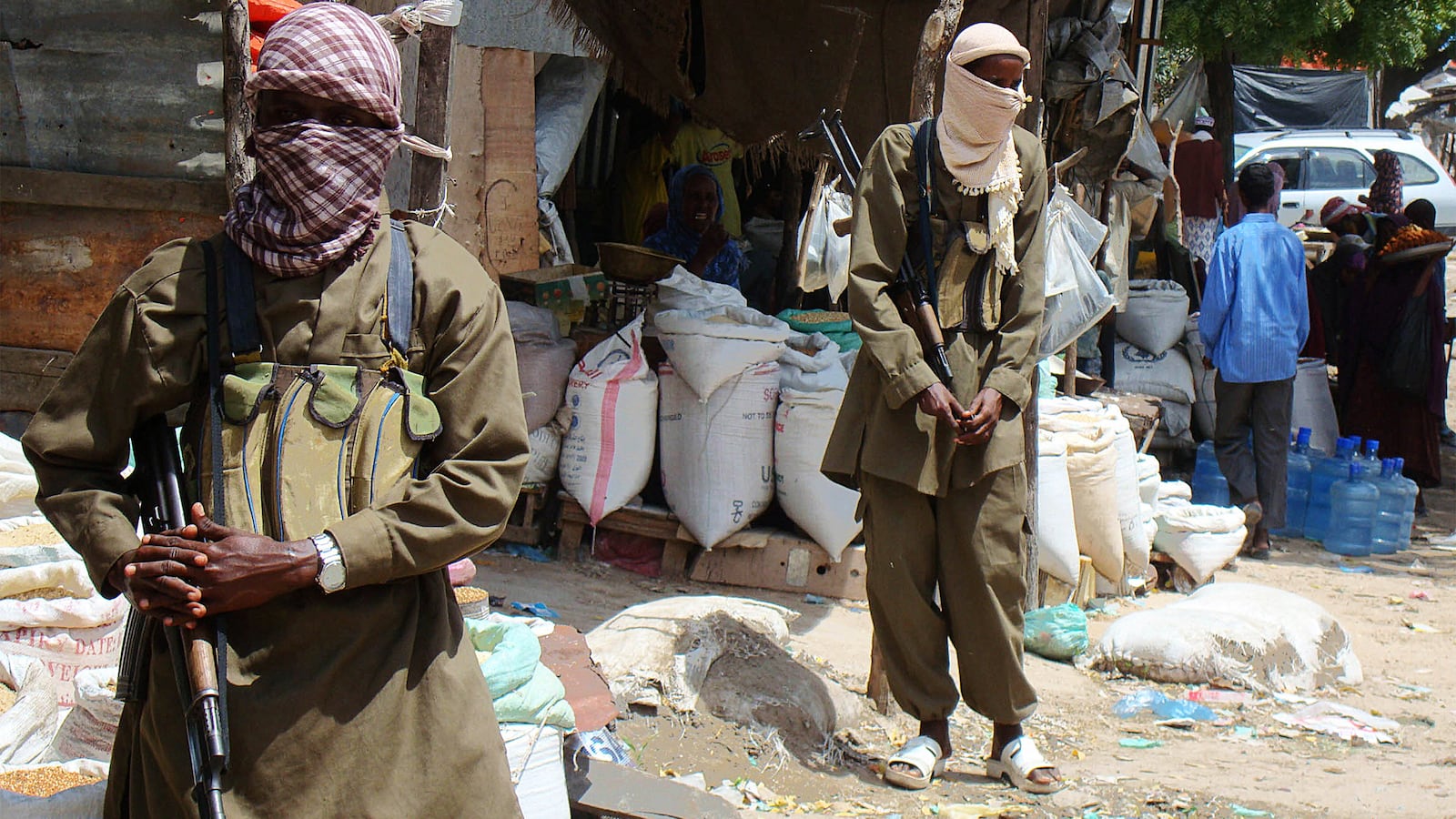MOGADISHU, Somalia—Thursday afternoon, as the head of U.S. Africa Command (AFRICOM) took center stage in a Pentagon press briefing room, Washington was buzzing with conflicting opinions about a controversial report. It was the culmination of a months-long AFRICOM-led investigation into the deaths of four U.S. Special Operators in October, but its findings raised as many questions as they answered.
As Gen. Thomas Waldhauser danced around tough questions from reporters, another AFRICOM controversy had already begun to unfold here in Somalia. Eighteen hours before the press conference began, his Special Operators had been in the midst of an “advise and assist” mission in the south of the country about which conflicting stories were beginning to emerge.
According to over a dozen locals in the village of Ma’alinka, and security officials in Mogadishu, Somali commandos had carried out an operation in the town on Thursday at around 1 in the morning here. Five locals were injured by the Somali commandos and at some point during a firefight with people whose identities no one could agree upon, five local people were killed.
At least one of those civilians’ injuries appear to be the result of the U.S.-trained Somali soldiers’ sloppiness, or under-preparedness, when carrying out the operation. But the question of how five locals were killed was stirring vocal controversy: Local security officials claimed Somali Special Forces killed three known al-Shabaab leaders after coming into contact with them in the town. The names of those militants do not match the names of the five locals killed; local townsmen claimed only civilians were killed, either after being targeted by Somali forces or caught in crossfire between Somali forces and neighboring farmers protecting the town; and U.S. Africa Command said it would assess allegations of civilian casualties.
The local accounts of the operation describe a textbook “advise and assist” operation with U.S.-trained Somali Special Forces taking the lead, backed up by the logistics and directions of the Americans: Helicopters presumably flown by Americans deposited Somali and U.S. soldiers a few kilometers outside their target; the joint force approached it on foot; American Special Operators stayed behind while their Somali counterparts carried out the mission itself; and once completed, they flew back to base.
This type of operation epitomizes the “by, with, and through” approach working alongside local forces that Waldhauser repeatedly emphasized in the Pentagon press conference to show that American lives are not typically at great risk in Africa despite the criticism resulting from the Niger ambush. Operations are conducted “by” local forces; “with” local forces if those forces are not yet able to operate independently; and “through” local forces and other partners in cooperative relationships built by ARFRICOM. “We don’t anticipate any additional [U.S.] forces,” Waldhauser told reporters. “It’s our role to work with partners to keep them in the lead as they conduct operations.”
But what happened in Ma’alinka also suggests the solutions Waldhauser is proposing deserve far greater scrutiny.
Ma’alinka could be described as your typical village in southern Somalia: It consists of little more than a mosque, two boreholes—crude wells—for water, a few small shops, some shanty homes, and farmland. But with floods cutting off the usual transport route from farming towns in Lower Shabelle to the region’s commercial hub, Afgoye, Ma’alinka has also become a transit hub for farmers and traders moving harvests to the marketplace.
It is located along a number of fault lines in the area: It’s on the border of the Biyomal clan’s territory, meaning it has in years past been home to skirmishes between the Biyomal militia and their rivals. And, like much of Lower Shabelle, the town is generally considered to be under al-Shabaab’s authority. But its proximity to an African Union Peacekeeping forward operating base, Lantabur, means that al-Shabaab militants tend not to spend long in the town center itself and are known to sleep in the bush, according to the civilians who live there.
Several townspeople own weapons and at least one of those weapons was registered with local authorities in 2012, according to paperwork seen by The Daily Beast. That AK-47 belongs to a local farm owner, although it’s used by his guard to protect one of the village’s boreholes from rival clan militias. People who pass through also pay small fees to buy water from the borehole and, with more and more locals using the village for transit, business at the borehole had been good in recent weeks.
On Wednesday evening, around 8 p.m. local time, roughly 30 people arrived in Ma’alinka with tractors they had used to take bananas to Afgoye. Having spent all day at the market there, which is open only on Saturdays and Wednesdays, they couldn’t reach their homes in the nearby town, Janale, before sunset, so they settled in for a night in Ma’alinka. When some asked townspeople for small mats to sleep on, Hassan Eelle, a local resident, obliged. He began chatting with three of them who were distant relatives from his clan, discussing how business was in the Afgoye market, whether their farms had produced good yield, and how tractors were the only—but they agreed not best—way of transporting the bananas they grew on their farms.
Eelle returned to his small corrugated tin home around 10 p.m., where he and his wife fell asleep in one of its two rooms. A few hours later, he estimates around 1 a.m., he woke to the sound of gunfire. He first thought it must be coming from a rival clan attacking the town, but then heard men speaking a foreign language and, confused, grabbed his wife and lay down on the ground inside their home, grains of sand from the earth floor pressed into his face.
His home is located on the northeast side of the village near one of the village’s boreholes, and Eelle could tell from the first “pop-pop-pop” he heard and the sound of the men’s voices that they were very close by. He would later learn that those few shots were coming from the guardhouse to the borehole where his friend Abdirahman Abdi, the borehole’s guard, was asleep with another local resident, Mahad Fanae.
Without money to buy khat and chew into the late hours of the evening, Abdi had fallen asleep earlier than usual that night. He told The Daily Beast that he had slept with his turban on, in which he kept his three rounds of ammunition, and the few cigarettes he had wrapped in his macawiis, the traditional Somali cloth men wrap around their waist. For a pillow he used the AK-47 he had to guard the borehole and the generator for it, which was in the room next to his in the little shelter.
He woke suddenly that night when two men kicked open his door, which he had left ajar and, without any words or warning, and began firing at him. “I was confused, the door opened and there were men with torches on their helmets there,” he said. “They just started firing without saying anything.”
One bullet grazed the left side of his head, and four others hit his right shoulder and forearm. Lying on his back with blood spilling from his head and arm, he could hear the men arguing in Somali about whether or not he was alive. Once they realized he was, they dragged him and Fanae, who remained unharmed, outside. Two others from the town, Mohamed Hersi and Abdullahi Mohamed, also had been pulled from wherever they were sleeping and apparently taken into custody. The Somali soldiers ordered the other men to bandage Abdi using the cloth from his turban. “They were shouting ‘you’re Shabaab, you’re Shabaab!’ and I told them, ‘I’m not Shabaab, ask these people in the morning and you will see I’m not Shabaab!’” he said.
Across from the generator guardhouse, those shots woke neighboring Abdi Dahir who had been asleep in his home about 20 meters north of the borehole. Assuming the gunfire was coming from a rival clan militia, he began to fire at the men entering the town and when they returned fire, he was shot in his thigh. As he heard the voices of those men he realized they were speaking Somalis speaking a foreign language, perhaps radioing back to Americans, and so, he thought, they couldn’t be a clan militia. Scared, he tossed his AK-47 into his goat pen, and took cover under a nearby tree.
The following morning as the sound of a helicopter could be heard leaving the area and townspeople emerged, scared, from their homes, they also learned that another home had been breached that night. According to Eelle, a woman and her daughter were inside the shanty home when the door was forced open by Somali soldiers. Those in the town believed that the women’s house had been broken into prior to Abdi’s. The Somali men didn’t fire at either her or her daughter and took nothing from the home, leaving Eelle and others to wonder what they were looking for inside.

Abdirahman Abdi after he was released from Digfeer Hospital in Mogadishu on Saturday.
Christina GoldbaumWhat was clear is that minutes after Abdi’s home was breached, a barrage of gunfire rang out near the southwest part of the town, near the tractors where the banana sellers were sleeping. At least two people, a teenage boy and teenage girl, were injured, and five people who had been sleeping on the tractors were killed. Their bodies were found near the village’s mosque a few meters to the west of the tractors’ location, likely where they ran for cover when the gunfire began.
Although the townspeople couldn’t tell if the five people had been shot from the front or back, the west-facing wall of the mosque was riddled with bullet holes the next morning, suggesting that while the Somali soldiers had entered the town from the northeast side, someone had also begun firing from the southwest side opposite the Somali soldiers’ position.
The question of who fired from the West remains unclear. Some locals claim it was farmers from neighboring lands who heard the first shots fired and assumed a rival clan was attacking the village. Somali security officials claim it was al-Shabaab or sympathizers to al-Shabaab who fired on Somali soldiers. If neighboring farmers had been forced by al-Shabaab militants to protect the terrain, as al-Shabaab often forces locals to do when militants themselves do not permanently reside in the areas under their control, those farmers could be punished by the terrorist group for not fulfilling that role.
Elders in Mogadishu whose clansmen were killed say they don’t know of anyone firing shots besides the Somali soldiers who had breached the two homes. The Somali Chief of Defense Forces claimed the Somali soldiers had killed three well-known al-Shabaab militants in the firefight, though the townsmen say they saw no trace of their bodies and did not admit to any knowledge they were in town.
One of the civilians injured, Abdi, was taken in the helicopter and dropped off by Somali Special Forces at a hospital in Mogadishu that night; the rest, except for one young girl who was treated in a local clinic, made their way to Mogadishu hospitals first on the back of a tractor, then a minibus the next morning. All were left to foot the hospital bill. Few were certain what really happened that night.
In places like Somalia with complex local dynamics that Americans still barely grasp decades after Black Hawk Down, nearly all decisions are made in what Carl von Clausewitz famously described as a “fog of greater or lesser uncertainty.” Here farmers and pastoralists carry weapons as readily as al-Shabaab militants; drought and floods mean those armed civilians move frequently across al-Shabaab terrain in search of pasture or traversable routes to commercial hubs; human intelligence is complicated by competing clan interests and decades-old clan rivalries; signal intelligence is complicated by frequent telephone calls between civilians and al-Shabaab members that don’t always indicate civilian complicity in al-Shabaab military activity; and the question of who is and who isn’t al-Shabaab is often as opaque to Somalis as it is to Americans.
Navigating this intelligence landscape is a difficult task for the American Special Operators who rotate in and out of the country every four or six months and who are charged with conceiving and planning the operations their local counterparts undertake. It also requires a high level of competency for those carrying out operations to, for example, ask a suspected militant to raise his hands before firing at him and only fire at him if he reaches for a weapon.
Ma’alinka is one example suggesting that these local forces—who are minimally trained in an environment all too familiar with war and often devoid of human rights—are ripe for operational, trigger-happy mistakes that can lead to civilian casualties and the loss of local support for the American mission.
Among the relatives of those injured and killed in Ma’alinka, the anger and frustration directed toward both the Somali and American military is palpable. “We don’t have anyone to advocate for us when our people are wrongly killed, when we go to government offices they ignore us and their [American] partners also ignore us,” said Fahan Mire Dirie, whose stepbrother, Mohamed Hashi Nur, was killed in Ma’alinka. “The people are without hope and the truth is buried.”
A day after the operation, AFRICOM released a statement saying that it is aware of reports alleging civilian casualties during the operation and will “review any information it has about the incident, including relevant information provided by third parties.”
“If the information supporting the allegation is determined to be credible, USAFRICOM will determine the next appropriate step,” it read.
But many Somalis are skeptical of accountability measures that exist for American and Somali commandos after a Somali-government and AFRICOM investigation into a similar incident last year in Bariire, southern Somalia. Immediately after the incident AFRICOM released a statement which, unlike the one released on Friday, said that: “We take any allegations of civilian casualties seriously and, per standard, we are conducting an assessment into the situation to determine the facts on the ground.”
An extensive Daily Beast investigation into the incident discovered that the American-led operation had resulted in the death of 10 Somali civilians who were specifically targeted while no al-Shabaab militants were killed; the operation had been advised against by African Union peacekeeping leadership in the region; the intelligence they had acted upon came from sources widely considered untrustworthy among locals; and U.S. diplomats had pressured the Somali government to bury the unfavorable findings of a Somali Federal Government-led investigation into the incident.
Still, 30 minutes after The Daily Beast article was published and in an apparent attempt to pre-empt the piece, AFRICOM released a statement claiming that it had completed its own assessment and determined that the only deaths were those of “enemy armed combatants.” Waldhauser later called for a Naval Criminal Investigative Service investigation into the incident after The Daily Beast’s reporting was raised in a congressional hearing on U.S. counter-terrorism in Africa. The NCIS investigation remains ongoing.
But as a result of AFRICOM’s initial assessment, many Somalis, particularly those related to the civilians killed, distrust Somali government and American-led investigations into civilian casualties—mistrust that can readily slip into disapproval of the American presence and American-trained Somali soldiers.
“Americans didn’t actually investigate, they never even asked any witnesses on the ground and then they forced the government to hide the results of their own investigation into Bariire,” Mahat Abdi Dore, a member of Somali parliament from Southwest State, told The Daily Beast. “I don’t trust the Americans when they say they will investigate civilian deaths, including in Ma’alinka.”
While questions of accountability linger in Somalia, Waldhauser’s statements about the Niger report suggest we will likely see more advise and assist missions like that of Ma’alinka. During the press briefing Thursday, Waldhauser emphasized that since the October ambush, guidelines have been introduced to reduce the likelihood that American forces themselves will face combat on the continent: the operations Americans do go on must now have a significant strategic effect, be accompanied by armed drones or a similar protective aircraft, and be vetted and approved by commanders higher on the chain of command than when the Niger operation took place.

MOMBASA, KENYA FEBRUARY 2: (SOUTH AFRICA OUT) One of the youth on top of the Masjid Musa as the police raid the mosque on February 2, 2014 in Mombasa, Kenya. Police raided the mosque saying militants were carrying out training there. During the raid some youths raised a black flag associated with al-Shabab. (Photo by Laban Walloga/Nation Media/Gallo Images/Getty Images)
Laban Walloga/Nation Media GroupFor U.S. operators on the ground, whose apparent itch for combat is blamed for the firefight in Niger that led to the controversial AFRICOM investigation, these guidelines make operating “by” themselves or “with” local forces increasingly difficult. And although the Trump administration’s Principles, Standards, and Procedures or P.S.P. removed several Obama era restrictions for U.S. Special Operations Forces outside convention battlefields, it maintains the “near certainty” requirement that no civilian bystanders are killed, limiting the ability of those forces to conduct airstrikes as well.
Though Obama-era Presidential Policy Guidance restricted Special Operations Forces to targeting only high-level leadership, that is no longer the case. So working “through” local partners is posited as the Special Operations Forces’ most readily available mechanism to target lower ranking al-Shabaab foot soldiers. Given that a high value target would likely be targeted by a drone strike or in an American-led raid, the inclusion of foot soldiers in the Trump P.S.P. opens the door for more frequent ground operations using local forces with Americans advising, such as in Ma’alinka.
In Somalia, the current federal government has welcomed this more aggressive approach. “America has the means and the materials to fight back against terrorists,” said Abdulaziz Ali Ibrahim, a spokesperson for the Somali Ministry of Internal Security. “We are dependent upon the international community and we want America to help us until the end of terrorism here.”
Congressmen and senators in D.C. have not offered similar support. After a closed-door briefing last Tuesday between the Senate Armed Services Committee and Waldhauser, along with Maj. Gen. Roger Cloutier, and two assistant secretaries of defense, lawmakers on both sides of the aisle emerged critical of the U.S.’ military approach in Africa.
Sen. Tim Kaine (D-VA), who described the briefing as “explosive,” told reporters: “I have deep questions on whether the military is following instructions and limitations that Congress has laid down about the mission of these troops in Africa.”
Questions also were raised about whether the U.S. should be investing its resources into a war to prevent a terrorist hub from emerging across the Sahel in north Africa and combating a terrorist group in Somalia that has little if any capable of carrying out an attack on U.S. soil.
“If we’re putting our highest value trained soldiers on capture and kill missions, they [the targets] should be individuals who threaten the country,” Sen. Dan Sullivan (R-AK) said, according to The Hill. “To me, I think this should be an opportunity to look at broader strategic issues.”
Waldhauser believes his “by, with, and through” strategy answers some of these questions, and the approach separates to some degree the Americans from ownership over or engaging in much direct combat in the African fight against terrorism. But it does not resolve the challenges American forces also faced in more traditional war zones like Iraq and Afghanistan: understanding the human terrain and adequately preparing local forces to take the mantle of providing national security.
In Somalia, U.S. forces are confronting both of these challenges. And in Ma’alinka, it’s unlikely all sides will agree on whether it was civilian farmers or al-Shabaab’s militants or their farmer-conscripts who returned fire on the U.S.-partnered force in the shootout. So, as we saw in the controversial Niger report and will see throughout the Americans’ military engagements across the continent, as the keys to accountability and lessons learned are lost in the fog of war, the big question that will keep coming back is, “Why are we there?”






